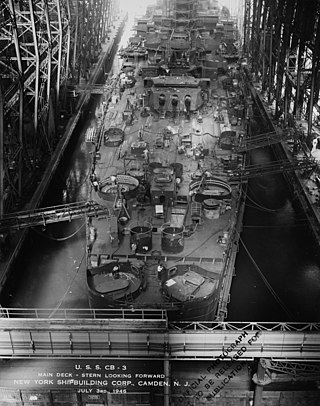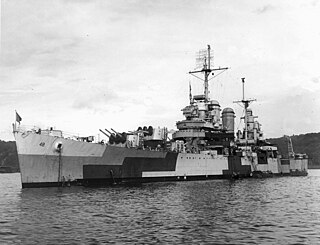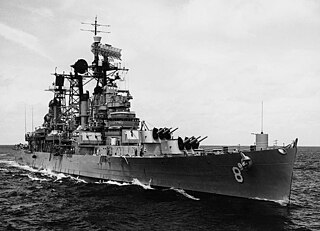
A cruiser is a type of warship. Modern cruisers are generally the largest ships in a fleet after aircraft carriers and amphibious assault ships, and can usually perform several roles.

USS Hawaii (CB-3) was intended to be the third member of the Alaska-class large cruisers. It was the first United States Navy ship to be named after the then-Territory of Hawaii. Because Hawaii's construction was delayed by higher-priority ships like aircraft carriers, her keel was not laid until December 1943, about two years after her sister ship Guam.

USS Dayton was a Cleveland-class light cruiser of the United States Navy, which were built during World War II. The class was designed as a development of the earlier Brooklyn-class cruisers, the size of which had been limited by the First London Naval Treaty. The start of the war led to the dissolution of the treaty system, but the dramatic need for new vessels precluded a new design, so the Clevelands used the same hull as their predecessors, but were significantly heavier. The Clevelands carried a main battery of twelve 6-inch (152 mm) guns in four three-gun turrets, along with a secondary armament of twelve 5 in (127 mm) dual-purpose guns. They had a top speed of 32.5 knots.

The Alaska class were six very large cruisers ordered before World War II for the United States Navy, of which only two were completed and saw service late in the war. The US Navy designation for the ships of this class was 'large cruiser' (CB) and the majority of leading reference works consider them as such. However, various other works have alternately described these ships as battlecruisers despite the US Navy having never classified them as such. The Alaskas were all named after territories or insular areas of the United States, signifying their intermediate status between larger battleships and smaller heavy and light cruisers.

USS Oklahoma City (CL-91/CLG-5/CG-5) was one of 27 United States Navy Cleveland-class light cruisers completed during or shortly after World War II, and one of six to be converted to guided missile cruisers. She was the first US Navy ship to be named for Oklahoma City, Oklahoma. Commissioned in late 1944, she participated in the latter part of the Pacific War in anti-aircraft screening and shore bombardment roles, for which she earned two battle stars. She then served a brief stint with the occupation force. Like all but one of her sister ships, she was retired in the post-war defense cutbacks, becoming part of the Pacific Reserve Fleet in 1947.

USS Portsmouth was a Cleveland-class light cruiser of the United States Navy, which were built during World War II. The class was designed as a development of the earlier Brooklyn-class cruisers, the size of which had been limited by the First London Naval Treaty. The start of the war led to the dissolution of the treaty system, but the dramatic need for new vessels precluded a new design, so the Clevelands used the same hull as their predecessors, but were significantly heavier. The Clevelands carried a main battery of twelve 6-inch (152 mm) guns in four three-gun turrets, along with a secondary armament of twelve 5 in (127 mm) dual-purpose guns. They had a top speed of 32.5 knots. Portsmouth was laid down in 1943, launched in September 1944, and commissioned in June 1945. By the time she completed her initial sea trials, the war had ended, so her career was short and uneventful. She made three overseas cruises to visit ports in Africa and the Mediterranean Sea between 1946 and 1948 before conducting training cruises later in 1948. The following year, she was decommissioned and assigned to the Atlantic Reserve Fleet, where she remained until 1970, when she was broken up.

The United States Navy's Boston class were the first guided missile cruisers in the world. Both ships in this experimental class were originally Baltimore-class heavy cruisers that had been decommissioned after World War II, but were redesignated as guided missile heavy cruisers (CAGs) and entered refit in 1952. The lengthy conversion and modernization project involved removing the aft triple 8-inch gun turret and its supporting structure and installation of two twin launchers for Terrier anti-aircraft guided missiles. The forward two 8-inch gun turrets remained unchanged. The forward superstructure was modified to include the Terrier's associated radars and electronics, the aft superstructure was completely replaced, and the Baltimore class's two funnels were trunked to one.

The Baltimore-class heavy cruisers were a large class of heavy cruisers in the United States Navy commissioned during and shortly after World War II. Fourteen Baltimores were completed, more than any other class of heavy cruiser, along with three ships of the Oregon City sub-class. The Baltimores also were the first cruisers in the US Navy to be designed without the limitations of the London Naval Treaty.

USS Springfield was a Cleveland-class light cruiser of the United States Navy, which were built during World War II. The class was designed as a development of the earlier Brooklyn-class cruisers, the size of which had been limited by the First London Naval Treaty. The start of the war led to the dissolution of the treaty system, but the dramatic need for new vessels precluded a new design, so the Clevelands used the same hull as their predecessors, but were significantly heavier. The Clevelands carried a main battery of twelve 6-inch (152 mm) guns in four three-gun turrets, along with a secondary armament of twelve 5 in (127 mm) dual-purpose guns. They had a top speed of 32.5 knots.

The Atlanta-class cruisers were eight United States Navy light cruisers which were designed as fast scout cruisers or flotilla leaders but which proved to be effective anti-aircraft cruisers during World War II. They were also known as the Atlanta-Oakland class. The Atlanta class originally had 16 x 5-inch (127 mm)/38 caliber guns in eight two-gun turrets, arranged with three superfiring turrets forward, three more superfiring aft and two waist mounts, one port and one starboard, giving the first four Atlanta-class cruisers the heaviest anti-aircraft armament of any cruiser of World War II. The last four ships of the class, starting with Oakland, had a slightly revised armament with a reduced main gun battery - the waist turrets being deleted - as they were further optimized for anti-aircraft fire in light of war experience.

The Brooklyn-class cruiser was a class of nine light cruisers built for the United States Navy between 1935 and 1938. Armed with five triple 6-inch (152 mm) gun turrets, they mounted more main battery guns than any other standard US cruiser. The Brooklyn-class ships were all commissioned between 1937 and 1939, in the time between the start of the Second Sino-Japanese War and before the invasion of Poland. They served extensively in both the Pacific and Atlantic theaters during World War II.

The Oregon City class was a class of heavy cruisers of the United States Navy. Although ten ships of this class were planned, only four were completed – one of those as a command ship. The three ships completed as cruisers were in commission from 1946 to 1980, one having been converted to a guided missile cruiser (CG).

Originally built as Cleveland-class light cruisers (CL) in the United States Navy during World War II, in 1957 three ships were re-designated as Galveston-class guided missile light cruisers (CLG) and fitted with the Talos long-range surface-to-air missile system. During the two-year refit under project SCB 140, the aft superstructure was completely replaced and all aft guns were removed to make room for the twin-arm Talos launcher and a 46-missile storage magazine. Three large masts were also installed in order to hold a variety of radars, missile guidance, and communications systems. Little Rock and Oklahoma City were simultaneously converted into fleet flagships under SCB 140A, which involved removing two forward dual 5-inch (127 mm) and one triple 6-inch (152 mm) turrets, and replacing them with a massively rebuilt and expanded forward superstructure. Galveston, in the non-flagship configuration, retained the Cleveland-class's standard forward weapons: three dual 5-inch (127 mm) and two triple 6-inch (152 mm) turrets.

Originally built as Cleveland-class light cruisers (CL) in the United States Navy during World War II, in 1957 three ships were re-designated as Providence-class guided missile light cruisers (CLG) and fitted with the Terrier surface-to-air missile system. During the two year refit under project SCB 146, the aft superstructure was completely replaced and all aft guns were removed to make room for the twin-arm Terrier launcher and a 120 missile storage magazine. Three large masts were also installed in order to hold a variety of radars, missile guidance, and communications systems. Providence and Springfield were simultaneously converted into fleet flagships under SCB 146A, which involved removing two forward dual 5-inch (127 mm) and one triple 6-inch (152 mm) turrets, and replacing them with a massively rebuilt and expanded forward superstructure. Topeka, in the non-flagship configuration, retained the Cleveland-class's standard forward weapons: three dual 5-inch (127 mm) and two triple 6-inch (152 mm) turrets.

The Albany-class guided-missile cruisers were converted Baltimore and Oregon City-class heavy cruisers of the United States Navy. All original superstructure and weapons were removed and replaced under project SCB 172. The converted ships had new very high superstructures and relied heavily on aluminium to save weight.

The Fargo-class cruisers were a modified version of the Cleveland-class cruiser design; the main difference was a more compact pyramidal superstructure with single trunked funnel, intended to improve the arcs of fire of the anti-aircraft (AA) guns. The same type of modification differentiated the Baltimore and Oregon City classes of heavy cruisers, and to a lesser degree the Atlanta and Juneau classes of light cruisers. Changes were made in order to reduce the instability of the Cleveland-class light cruisers, especially their tendency to roll dangerously. The main battery turrets sat about a foot lower and the wing gunhouses were lowered to the main deck. The medium (40 mm) anti-aircraft mounts were also lowered.

The Denver-class cruisers were a group of six protected cruisers in service with the United States Navy from 1903 through 1929. Authorized by Congress in 1899 as part of the naval buildup touched off by the Spanish–American War, they were designed with peacetime duties on foreign stations and tropical service in mind, specifically patrolling Latin America and the Caribbean. However, they had insufficient armament, armor, and speed for combat with most other cruisers. Thus, they were also called "peace cruisers" and were effectively gunboats. They were intended to augment the Montgomery class in these roles.

The Juneau-class cruisers were United States Navy light cruisers that were modified version of the Atlanta-class cruiser design. The ships had the same dual-purpose main armament as USS Oakland with a much heavier secondary antiaircraft battery, while the anti-submarine depth charge tracks and torpedo tubes were removed along with a redesigned superstructure to reduce weight and increase stability. Three ships were ordered and built, all completed shortly after World War II, but only Juneau remained active long enough to see action during the Korean War.
The Neptune class was a proposed class of cruisers planned for the British Royal Navy in the latter years of the Second World War. They were large ships which were to be armed with twelve 6-inch (152 mm) dual-purpose guns and with a heavy secondary armament. Although five ships of the class were planned in 1944, they were cancelled following the end of the war and before construction could begin.

The CL-154 class of 5-inch (127 mm) gun light cruisers was a United States Navy project from the last two years of World War II, with antecedents reaching back to 1938 and earlier. The CL-154 class was contemporary to the 6-inch (152 mm) gun Worcester-class light cruisers and the 8-inch (203 mm) gun Des Moines-class heavy cruisers: like them the CL-154 design incorporated the lessons learned of World War II combat. The Navy allocated six hull numbers to the CL-154 class for the planned construction, but unlike the Worcester and Des Moines classes the CL-154 class would be cancelled with no units named or constructed. Had these ships been built, they would have been given the hull classification CLAA on 18 March 1949.



















